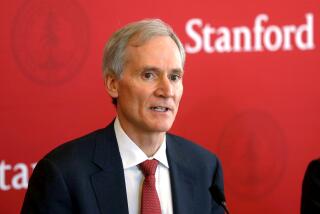Physicist is found guilty of misconduct
- Share via
A Purdue University physicist who claimed to have demonstrated a tabletop fusion process that could revolutionize energy production is guilty of research misconduct in asserting that his findings were independently reproduced, a university committee said Friday.
The panel did not investigate whether Rusi P. Taleyarkhan fabricated his widely publicized and highly controversial research but whether he intentionally misled the scientific community in claiming that his work had been independently replicated.
It has been six years since Taleyarkhan’s original publication, and no one else has been able to duplicate his findings, said physicist Michael J. Saltmarsh, who is now retired from the Oak Ridge National Laboratory and had tried unsuccessfully to replicate the work.
Taleyarkhan was using a well-known technique called sonoluminescence, in which sound waves are used to collapse bubbles in a liquid, creating very high concentrations of energy and light. The technique is already used for such purposes as catalyzing chemical reactions, cleaning badly contaminated surfaces, and melting fat during liposuction.
In a 2002 paper touted on the cover of the prestigious journal Science, Taleyarkhan reported that he had used sonoluminescence on acetone in which the hydrogen atoms had been replaced with deuterium. The high temperature and pressure, he said, produced nuclear fusion, generating neutrons and tritium.
The article was published over the vehement objections of several reviewers and was heavily criticized by other physicists.
While researchers tried to duplicate the experiment, Taleyarkhan set his postdoctoral fellow Yiban Xu to the task.
Xu observed the critical fusion products and prepared a paper that was submitted to Science under his name. The paper was rejected, in part because referees maintained that he could not have carried out the experiments alone.
According to the report by the Purdue committee -- composed of scientists from inside and outside the university -- Taleyarkhan asked master’s candidate Adam Butt to review Xu’s data. Butt’s name was then added to the paper, even though he had not participated in the research.
That, said the panel, was clearly scientific misconduct because it was designed to give the appearance of a collaboration that had not occurred.
Meanwhile, Taleyarkhan made heavy revisions to the paper, in grammar and scientific content, according to the panel. The paper was ultimately published in 2005 in the journal Nuclear Engineering and Design with virtually no mention of Taleyarkhan’s participation.
The wording of the paper suggested that the work had been performed with funding and guidance from physicist Lefteri Tsoukalas, chairman of the department.
In a 2006 paper in Physical Review Letters on his own work, Taleyarkhan asserted that his original observations reported in the Science paper “have now been independently confirmed.”
The Purdue committee, however, concluded that Taleyarkhan was heavily involved in Xu and Butt’s paper and that “the direct assertion of independent confirmation . . . is falsification of the research record and thus is research misconduct.”
Taleyarkhan now has 30 days to respond to the committee’s findings. A university spokesman said the school would have no comment until the 30 days had elapsed.
Taleyarkhan did not respond to phone and e-mail messages.
The panel’s findings “do not clear up the central issue of the research,” which is whether tabletop fusion is real, said chemist Kenneth S. Suslick of the University of Illinois.
Suslick characterized Taleyarkhan’s Science paper as “sloppy . . . but not fraudulent,” adding: “There is serious reason to believe that [his] later work might have been tampered with. . . . Among the scientific community, he no longer has any credibility.”
--






